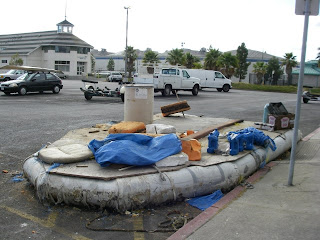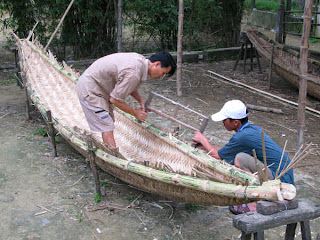This place used to be called the Lowie museum, named after an anthropologist. Something must have happened to trigger the name change, probably a gift of money. That's usually what motivates change.
So anyway, Mike Livingston was in town and he had never seen the baidarka frame at the museum before, so we went to visit it. Mike also arranged for us to see a bunch of baidarka models that were in the museum storage.
I wasn't expecting to see much new stuff since I had been to the museum twice before. And models tend not to offer much insight either. So all in all, my expectations were low. But as it turned out, I did learn a bunch of new stuff and noticed things that I hadn't noticed before. So overall, this turned out to be quite an enlightening trip.
A few photos and some brief comments follow. This is not a full analysis of the situation which I hope to work up and post somewhere but just a quick overview of what I noticed.

Here is a picture of the bow of the Aleut kayak from Atka. Of special note is the lashing at the top that ties the deck stringer to the bow plate. You might have to click on the photo for a larger view to see it clearly. Anyway, the string goes through the deck and then through a hole in the vertical part of the bow assembly.
What I noticed was that this was one of a number of modifications to the boat made by someone other than the original builder. My suspicion that it was other than the original builder who made the add-ons is based on two things. The original build was of very high quality and workmanship. And the builder didn't paint the frame red until all the building was done, including the boring of holes. What makes me think that the bow lashing was an add on is that the holes are rougher than the original lashing holes and that they are not painted, that is the boring of the holes exposed fresh wood.
 The same goes for the stern. A new lashing was added to tie the tail fin into the stern cross block. Not shown here are three more additions that would reduce the flex of the frame. Apparently, the add ons were made to stiffen up the boat. Why would someone want to stiffen up the boat? Apparently to sail it.
The same goes for the stern. A new lashing was added to tie the tail fin into the stern cross block. Not shown here are three more additions that would reduce the flex of the frame. Apparently, the add ons were made to stiffen up the boat. Why would someone want to stiffen up the boat? Apparently to sail it.
Here is the mast step add on lashed to the ribs. We saw the sail that was used with this boat, but didn't take it out of its plastic bag.

We looked at a bunch of baidarka models as well. For some reason, all but one were two-holers. No singles. As I already mentioned, I wasn't expecting much since models are usually not to scale and distorted for ease of building, but these were quite accurate. The detail on the deck gear and paddles was especially revealing. What sets these models apart from some others I have seen is that they were apparently made by men who had also done the full size boats and gear, so the detail was quite authentic. I especially noticed the paddles. The one pictured above and below was of the short loom variety. I don't think that all paddles of that period had short looms, but some definitely did. Looms were on the order of 18 to 20 inches and blades were on the order of 40 inches.

 Here is a picture of a guy holding his short loom paddle. I think that paddlers held these paddles like Greenlanders held their short loom paddles, that is, thumb and forefinger curled around the loom at the root of the blade and the rest of the hand sitting on the root of the blade.
Here is a picture of a guy holding his short loom paddle. I think that paddlers held these paddles like Greenlanders held their short loom paddles, that is, thumb and forefinger curled around the loom at the root of the blade and the rest of the hand sitting on the root of the blade.

















